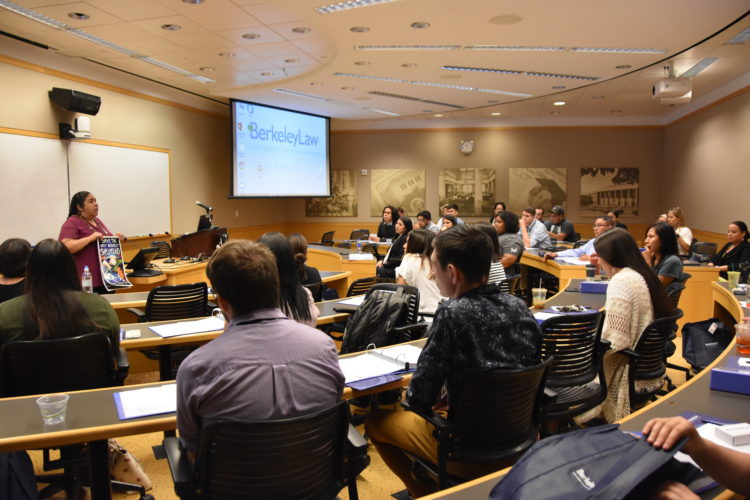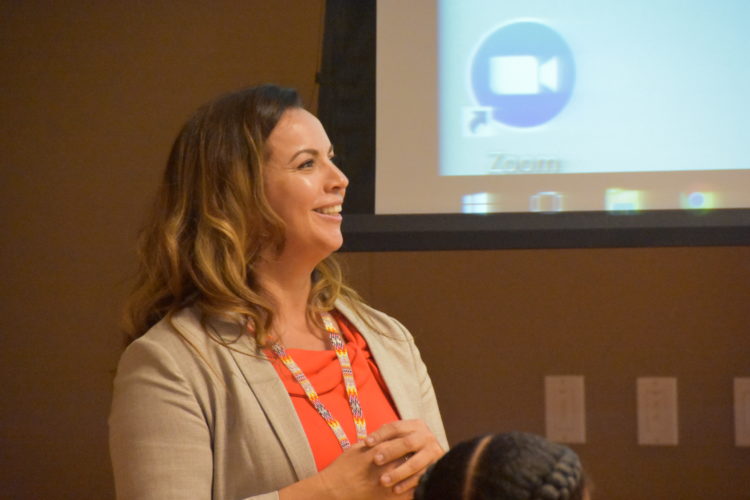Berkeley Law opening new doors for Native American students
The reconstitution of the Berkeley chapter of the Native American Law Students Association led to this week's set of workshops at Berkeley Law
June 27, 2019

Corrina Gould of the Confederated Villages of Lisjan/Ohlone, far left, presented an invocation to the Pipeline To Law Initiative on Wednesday. (UC Berkeley photo by Hulda Nelson)
This week, Native American college students are considering law as a profession at a five-day admissions workshop on campus called the Pipeline to Law Initiative. It’s the first time the three-year-old program has been offered at Berkeley Law.
The Native American Law Students Association (NALSA) has reinvented itself on campus during the past school year, and the hope is that the initiative, which got underway Wednesday, also will help reintroduce Native American issues at Berkeley Law and across the campus.
“This university was founded on Indian land, and as an institution, we need to invite the Native American community into it,” Kristin Theis-Alvarez, dean of admissions and financial aid at Berkeley Law, says. “We have to make sure that we are reaching out to them in a positive and respectful way.”
Theis-Alvarez and her counterpart at Arizona State University (ASU), Kate Rosier, have spent the past five years developing the Pipeline to Law Initiative, although the program has only been formally in operation for three years. In that time, workshops and get-togethers have been held at ASU, Michigan State University, the University of South Dakota and the University of Washington.
This time, it’s at Berkeley Law, and 36 participants representing 21 different tribal nations from around the country are among the workshop participants.

Kristin Theis-Alvarez, Berkeley Law’s dean of admissions and financial aid, is the co-creator of the Pipeline To Law Initiative. (UC Berkeley photo by Hulda Nelson)
The workshop, designed for college sophomores, juniors, seniors, graduate students and students preparing for law school, is offering test prep support, networking, mentorship, information about law school application criteria and law school funding options and the opportunity to hear from former and current Native American law students.
The workshop is being sponsored by law school programs at ASU, Michigan State, Berkeley and South Dakota, in addition to the National Native American Bar Association, the Princeton Review Foundation and the ASU branch of NALSA.
“Less than 1 percent of all LSAT (Law School Admissions Test) takers identify as Native American,” Theis-Alvarez says. “It’s about the same percentage for applications to law schools. What that means is that there are very few native lawyers, something like four of them per (the 573) federally-recognized tribes. We hope to do something about that.”
First-year Berkeley Law student Dallas Lopez, who was the force behind reconstituting NALSA on the Berkeley campus after a lengthy hiatus, could not be more excited, despite knowing that the Pipeline to Law Initiative is not designed exactly for someone like him, since he’s already in law school.
“I grew up in a community around other Native Americans, never knowing that the law was an option,” says Lopez, who calls Arizona’s Gila River Indian Community home. “That was true, I think, for many of us. When I decided to pursue law, my entire tribe got excited. We have a large tribe, relatively, with 22,000 people, but we have relatively few lawyers, so it was a big deal.
“But it was a hard, isolating experience because there was no one to guide me along the way. What I’ve come to learn in talking to friends is that the Native Americans who have done well have been the ones who have done the Pipeline. This is a great opportunity for others to take a look at the law.”
Naya Coard, one of the first recruits to Berkeley NALSA last fall, describes the organization as “my safe space” after leaving Long Island, New York, where she grew up as a member of the Shinnecock Tribe. She doesn’t have any experience with the Pipeline to Law Initiative, but that’s about to change.
Her sister, Aiyana, has traveled to Berkeley from the University of North Carolina-Greensboro to take part this week in the workshop, “and she is super excited,” Coard says.
“She recently got interested in applying to law school,” Coard explains. “She’s big into social justice, women’s empowerment and other issues having to do with the black and brown communities. For her, the chance to do this and network with faculty members is terrific.”

UC Berkeley law professor Seth Davis addresses the crowd on the first day of the Pipeline To Law Initiative. (UC Berkeley photo by Hulda Nelson)
Hosting the Pipeline to Law Initiative at Berkeley caps a big year for the Native American law community here. A year ago, Lopez learned about NALSA and that Berkeley’s chapter was long inactive. At the time of this discovery came the knowledge that he had about 24 hours to put together an executive board to have the Berkeley chapter reactivated for the 2018-19 school year. Working together with Seth Davis, a professor at Berkeley Law and co-author of the 2017 supplement to Cohen’s Handbook of Federal Indian Law, the deadline was met.
“One amazing part of Berkeley Law is that NALSA had been dormant here for a long time,” Lopez said. “But there was an alumnus who was willing to help out financially to get us going, and now we have 15 to 18 members, most of them 1-Ls (first-year law students). And we could have five or more coming in the fall.”
That steady rise in incoming Native American talent could be a game-changer. Lopez says the group is hoping to reconnect with alumni and to develop a scholarship program. More than that, he says he sees Berkeley becoming a go-to destination for prospective Native American lawyers.
“None of the top-tier law schools is creating new space for native law study and native scholarships,” Lopez says. “Berkeley can do that. We are making the case for that.”

Pipeline To Law Initiative co-founder Kate Rozier from Arizona State University makes full use of the white board at the start of this week’s workshop at Berkeley Law. (UC Berkeley photo by Hulda Nelson)
There are bound to be growing pains.
“In the short term, I believe we just need to keep the program running and get the word out,” Berkeley NALSA board member Emiliano Aguirre says. “In the long term, I believe the focus should be on introducing law and its capabilities to Native American children.
“I grew up on the Navajo reservation, where a lot of the children are not introduced to areas such as finance, economics, STEM or law. There are so many fascinating career paths within each of these areas.
“I believe getting kids interested in law can be accomplished by working with local schools, after-school programs and organizations that work with the youth. I’ve seen STEM-related workshops in local communities. I strongly believe the same can be done for law.”
One of the outcomes resulting from the return of NALSA to Berkeley is that the campus was awarded host duties for a moot court next spring. Moot courts bring together groups of law students from schools around the country, and participants take part in simulated court or arbitration proceedings.
This time around, Davis is writing the case that will be argued, giving participants the chance to take a dive into law from the Native American point of view.
“Some of us were able to go to the last one in Albuquerque in March,” Lopez says. “With help from professor Davis and (Berkeley Law Dean Erwin) Chemerinsky, it all somehow got willed together, and our presentation won out to host moot court. What I’m hearing is that this will be the biggest moot court ever.”
From the return of NALSA to the Pipeline to Law Initiative to moot court and its expected influx of 400 law students, faculty and lawyers, there is a sense that Berkeley could become a destination for Native American students, something that Theis-Alvarez says Berkeley “has been chipping away at for about a decade.”
“We’re reaching a critical mass here with Native American students,” Theis-Alvarez says, “and we’re empowering them.”